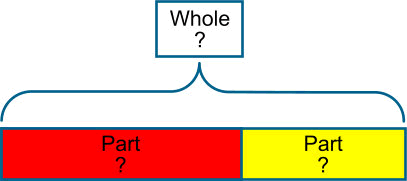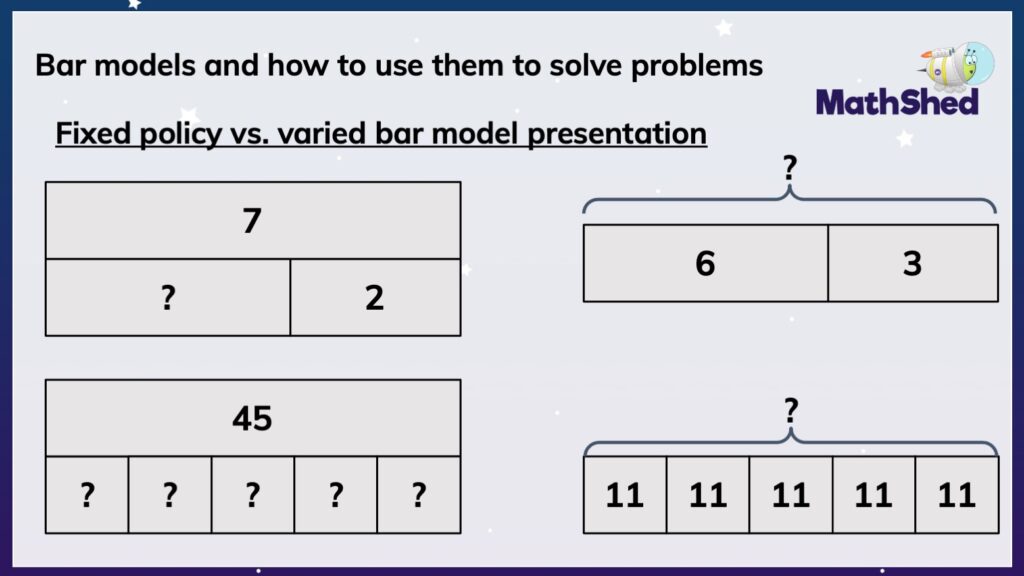Build student confidence in math with effective bar model drawing techniques
Wiki Article
Exploring Bar Model Drawing Techniques: A Comprehensive Guide to Picturing Math Concepts
Bar version attracting strategies act as a useful source for both educators and students in envisioning mathematical ideas. These designs streamline complex mathematical partnerships, assisting in the understanding of enhancement, subtraction, division, and reproduction. This guide outlines effective techniques for executing bar designs, fostering active involvement and real-world links. As visitors check out the practical applications and training suggestions, they will certainly discover exactly how these techniques can transform their method to maths.Recognizing the Basics of Bar Model Drawing
Bar design attracting offers as an effective aesthetic device in mathematics, facilitating the understanding of analytic methods and numerical partnerships. This method involves representing numbers and their relationships via rectangular bars, making it much easier to picture operations such as addition, subtraction, multiplication, and division. Each bar's size matches to a certain value, allowing learners to compare quantities and recognize proportions clearly.To produce a bar model, one begins by recognizing the problem's essential aspects, commonly simplifying into parts that can be aesthetically stood for. In an easy enhancement problem, two bars can be drawn, with their sizes representing the addends. The mixed size highlights the sum. On top of that, bar designs can be adapted for more intricate problems, including portions and proportions, by adjusting benches appropriately. Grasping these essentials lays a strong foundation for efficient problem-solving and deeper mathematical understanding.
Advantages of Utilizing Bar Versions in Mathematics
Utilizing bar models in mathematics uses many advantages that improve knowing and understanding. These graphes help trainees in realizing complicated principles by breaking them down right into manageable parts. Bar versions give a clear structure for showing connections between numbers, making abstract ideas more concrete. They advertise a deeper understanding of mathematical operations and promote analytical by permitting students to imagine the data they are working with.In addition, bar models support the advancement of essential thinking abilities, as students must analyze and analyze the visual info to draw conclusions. This approach motivates active interaction with the material, reinforcing retention and proficiency of mathematical concepts. By promoting a solid structure in visual proficiency, bar versions equip students to come close to numerous mathematical challenges with confidence. Generally, the integration of bar models into maths education and learning shows beneficial in cultivating both comprehension and analytical capabilities among trainees.
Applying Bar Designs to Enhancement and Subtraction
Bar designs work as an effective tool for aesthetically representing addition and reduction issues. By illustrating the relationship in between numbers, they boost understanding and assist in analytical. In enhancement, real-life applications of these designs can assist learners grasp mathematical principles in functional contexts.Representing Addition Aesthetically
Visual help can greatly enhance their understanding of these operations when students come across enhancement and subtraction issues. Bar models function as effective devices for representing enhancement. By separating a rectangular shape into segments that represent the numbers entailed, trainees can imagine the relationship between the quantities. As an example, if a pupil needs to include 3 and 5, they can produce a bar divided right into two sections: one area standing for 3 and the various other standing for 5. This clear representation not only streamlines the enhancement procedure however also enhances the concept of combining quantities. As trainees manipulate these visual aids, they establish a much deeper understanding of addition, resulting in boosted analytical skills and better confidence in their mathematical abilities.
Reduction With Bar Versions
Reduction is commonly viewed as a more complex operation than addition, bar models can properly clarify this process for trainees. By aesthetically standing for the amounts entailed, students can much better understand how numbers connect to one another. In a bar version for subtraction, one bar stands for the overall, while one more indicates the amount being deducted. This aesthetic distinction aids pupils grasp the principle of "taking away." For example, if a bar shows 10 devices, and another bar representing 4 systems is gotten rid of, students can quickly see that 6 systems stay. This technique not only fosters understanding of reduction however also help in establishing analytical abilities, allowing trainees to envision their mathematical reasoning and improve their general understanding of mathematical concepts.Real-Life Application Instances
Comprehending subtraction through bar models lays a foundation for using these techniques in real-life circumstances. In numerous contexts, such as budgeting or purchasing, people can envision just how much money continues to be after expenditures. For example, if an individual has $50 and spends $20, a bar design can stand for the complete amount and the spent section, highlighting that $30 is left. In addition, moms and dads can use bar models to assist kids comprehend the amount of more products require to be included in complete a collection, such as having 3 apples and needing five. This graph streamlines complex troubles, facilitating understanding and retention. Inevitably, bar designs work as efficient devices in everyday decision-making, improving mathematical understanding in practical situations.Imagining Reproduction and Division With Bar Models
In checking out the application of bar designs for reproduction and department, it is important to realize their fundamental concepts. Creating reproduction designs enables students to envision partnerships between numbers, while efficient department techniques can be shown with these visual aids. This method boosts understanding and problem-solving abilities in mathematics.Comprehending Bar Models
Bar designs act as an effective aesthetic device for highlighting the ideas of multiplication and department. They make it possible for students to stand for mathematical connections in a structured style, promoting a deeper understanding of these operations. In reproduction, bar versions show groups of equivalent size, enabling individuals to visualize the complete quantity when combining these groups. Alternatively, in division, bar models aid show exactly how a total is separated right into smaller sized, equivalent parts, clearing up the idea of partitioning. By utilizing these visual aids, students can comprehend the underlying concepts of multiplication and department better. This method not just improves understanding however likewise supports analytical skills, making bar versions a very useful possession in mathematical education and learning.Building Multiplication Versions
Creating reproduction designs making use of bar layouts offers a clear method for envisioning the procedure of multiplication. These designs make it possible for students to stand for reproduction as groups of equal components, making abstract ideas extra concrete. As an example, to illustrate (3 times 4), a trainee can draw one bar divided into 3 equivalent segments, each representing four units. Furthermore, producing a 2nd bar with the same size enhances the understanding of repeated enhancement, as each sector corresponds to one team. This visual depiction not just aids in grasping reproduction however additionally enhances analytical skills. By using bar models, students can better understand connections in between numbers and develop a durable foundation for extra complex mathematical concepts, bring about raised self-confidence in their capacities.Envisioning Division Methods

Addressing Word Problems Utilizing Bar Version Techniques

In a problem including addition and reduction, trainees can attract different bars for each amount and then manipulate them to locate the remedy. This process not just clears up the problem but additionally cultivates a much deeper conceptual understanding. Bar versions can be adjusted for numerous types of word troubles, making them functional across different mathematical topics. Inevitably, utilizing bar versions can substantially boost students' analytic skills by giving a clear aesthetic path to arrive at the proper response.
Integrating Bar Versions in Various Mathematics Topics
Bar designs can be perfectly integrated right into different math subjects, improving pupils' understanding of concepts past standard arithmetic. In algebra, these aesthetic tools help in representing inequalities and equations, allowing learners to picture partnerships in between variables. When tackling geometry, bar models can illustrate the homes of forms and spatial thinking, helping trainees grasp ideas like area and perimeter effectively. In data, bar models help with the interpretation of data collections, permitting pupils to contrast amounts and acknowledge patterns visually. Additionally, integrating bar versions within dimension subjects aids in recognizing units and conversions by providing a tangible representation of quantities. By using bar models across various mathematical locations, instructors can foster a deeper comprehension of complex ideas, thus boosting analytic skills and promoting crucial reasoning (bar model drawing techniques). This convenience shows the energy of bar designs as a fundamental tool for pupils in their mathematical tripTips for Mentor Bar Designs Effectively
Integrating bar models right into mentor methods needs thoughtful approaches to maximize their efficiency. Educators needs to start by introducing bar designs with basic, relatable examples that students can conveniently comprehend. This assists to develop self-confidence and familiarity with the idea. Slowly raising the complexity of troubles permits students to use their skills progressively. Additionally, instructors should motivate trainees to create their own bar versions, promoting energetic involvement and possession of their knowing.Integrating collective tasks can additionally improve understanding, as students go over and fix issues in teams. Constant responses is necessary; educators need to supply useful discourse on students' bar version depictions to guide enhancement. Ultimately, attaching bar versions to real-life situations reinforces their importance, assisting students see the sensible applications of their mathematical abilities. By implementing these techniques, instructors can successfully harness the power of bar versions in their mathematics direction.
Often Asked Inquiries
Can Prevent Models Be Made Use Of in Other Subjects Besides Math?
Bar models can certainly be made use of in various topics past math. They effectively illustrate ideas in scientific research, social researches, and language arts, helping to visually stand for connections, procedures, and concepts for enhanced understanding throughout disciplines.What Age Is Best Suited for Discovering Bar Designs?
Bar versions are best suited for children ages 7 to 12, as they create concrete thinking skills during this period (bar model drawing techniques). At this age, pupils can properly understand abstract ideas with visual representation and analytical methodsExist Digital Devices for Creating Bar Designs?

Just How Can I Evaluate Pupil Recognizing of Bar Models?
Evaluating pupil understanding of bar versions can include quizzes, empirical assessments, and team conversations. Educators might additionally examine students' completed models and their ability to discuss their thinking, making sure a complete assessment of comprehension.What Prevail Mistakes When Using Bar Versions?
Usual mistakes when utilizing bar designs include misstating amounts, failing to properly label bars, confusing addition and reduction, overlooking to utilize regular ranges, and ignoring the significance of clear aesthetic separation in between different aspects.In enhancement, bar models can be adapted for extra intricate troubles, including ratios and fractions, by readjusting the bars as necessary. Reduction is typically perceived as a much more complicated operation than addition, bar versions can successfully clarify this process for pupils. In a bar model for subtraction, one bar stands for the overall, while one more suggests the quantity being subtracted. If a bar reveals 10 units, and another bar representing 4 units is removed, pupils can quickly see that 6 units stay. When separating a total amount right into equivalent teams, pupils can draw a lengthy bar to stand for the entire and after that segment it into smaller bars that suggest each team.
Report this wiki page